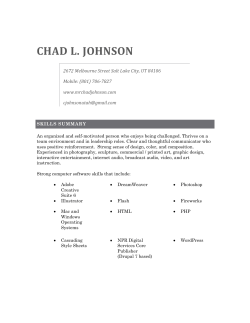
Engineering students at Weber State University display a Hovercraft Autonomous... Vehicle (HATV) they developed for possible use in U.S. Air...
Engineering students at Weber State University display a Hovercraft Autonomous Target Vehicle (HATV) they developed for possible use in U.S. Air Force pilot training. The landspeeder-like vehicle is one of numerous aerospace research projects overseen by the Utah Center for Aeronautical Innovation and Design. (Photo Credit: Weber State University), “FROM MILITARY LANDING GEAR TO LOW-NOISE BIKE RACKS, UTAH ENGINEERS SEARCH FOR AEROSPACE SOLUTIONS” ** Just as NASA research has been responsible for a plethora of products such as smoke detectors, flat panel TVs, fogless ski goggles and freeze-dried foods, aerospace engineering continues to surface in the most surprising areas. Based at Weber State University in Ogden, the Utah Center for Aeronautical Innovation & Design (UCAID) searches for industry partners to develop research projects with commercial applications. In Utah Gov. Gary Herbert’s State of the State address last year, the university was praised for generating more engineering and technology jobs. “By focusing on workforce needs in this area, we will develop the talent and innovation necessary to become the premier player in the aerospace industry,” Herbert pledged. “As this happens, Utah becomes more than a place companies would like to be, it becomes a place they need to be.” Located near Hill Air Force Base, which provides the engineering for the F-16 Fighting Falcon, the A-10 Thunderbolt II and the Minuteman III Intercontinental ballistic missile, UCAID plays a significant role in testing new high-grade materials to make military aircraft components more resistant to corrosion and surface cracking. But the engineering unit was also instrumental in developing the Wasatch Powder Monkey quick-release bicycle roof rack. The Utah company’s “SmartCrossbars” were aerodynamically designed to reduce wind noise and drag on the top of a vehicle, improving gas mileage. “Our work is interesting and challenging everyday,” says UCAID mechanical engineer Jim Watts. “I enjoy the diversity of our projects.” In what is bound to astound millions of Star Wars fans, the researchers have brought Luke Skywalker and Obi Wan Kenobi’s landspeeder to life. In two separate projects, UCAID engineers and Weber State University engineering students have created Hovercraft Autonomous Target Vehicles (HATV) that are propelled above the ground on bursts of air. In tests last fall on Utah’s wide-open Salt Flats, the hovercraft reached speeds of 55 miles per hour. Roughly the size of a pickup truck, the HATV may be eventually used in USAF pilot training during target practice exercises. The motors give off heat signatures picked up by the pilot’s missile systems. Sci-fi fantasies aside, you likely have come across a UCAID invention without even realizing it. Every door on Boeing 767 planes now contains new carbon fiber springs holding them up instead of titanium ones, which had to be frequently replaced. The new composite materials tested at UCAID labs are stronger, lighter and less vulnerable to rust. “We saved them 110 pounds per door,” says Watts. “Airplane doors weigh quite a lot.” Collaborating with ATK Aerospace Structures, UCAID developed and tested new carbon fiber springs that now hold up the exit doors on Boeing 767s. The springs are stronger and more stress-resistant than the plane’s old titanium springs, which needed to be replaced frequently. (Photo courtesy of UCAID) UCAID is also partnering with the Metal Improvement Company, a subsidiary of the Curtis-Wright Corporation, to test laser peening technology on cheaper alloy steels. Laser peening is when metal is compressed and hardened after absorbing a high repetition of laser bursts. The project is being funded by a Utah Science Technology and Research (USTAR) grant aimed at creating more “knowledge economy” jobs. The laser peening approach could be used by the military to strengthen landing gear components for U.S. Air Force and U.S. Navy aircraft – and has numerous possible commercial applications. “Based on the high-cost steels the military is using now, this could potentially generate considerable savings on parts,” Watts says. Watts recently used DraftSight, Dassault Systemes’ no-cost 2D CAD product, to design the ring-shaped test samples of the laser-peened steel. Bolts are progressively tightened inside the rings to measure stress resistance. And the rings are repeatedly soaked in a brine solution and dried to determine the steel’s threshold for cracking. “Our 2D drawings are nothing glamorous,” Watts says. “But when I need to make a simple drawing, DraftSight is the easiest way to do it.” “It’s intuitive, easy to learn and I like checking out the tutorials on YouTube,” he adds. Most of UCAID’s design work is done in 3D SolidWorks. Watts heard about the convenience of DraftSight from a SolidWorks rep he met at the Association for Unmanned Vehicle Systems International (AUVSI) trade show in Denver. Developing remotely piloted Unmanned Aerial Vehicles (UAV) is also one of UCAID’s core areas of expertise. Watts says he and his colleagues are now developing a tiny remote control blimp – the size of a fat cigar – that Utah police may use to monitor highcrime neighborhoods at night. “It will be their eye in the sky,” Watts says. “Unlike the mini-helicopters available now, the blimp can just float around there for five or six hours. There’s not much battery drain.” -- END --
© Copyright 2025





















